“. . .and there lies Santa Barbara on its plain, with its amphitheatre of high hills and distant mountains. There is the old white Mission with its belfries, and there the town, with its one-story adobe houses, with here and there a two-story wooden house of later build. . . in the golden sunlight and glorious climate, sheltered by its hills. . .and there roars and tumbles upon the beach the same grand surf of the great Pacific. . .”
-An excerpt from Richard Henry Dana’s maritime travel narrative titled, Twenty-Four Years After (1869).
As the sun slipped above the hills east of town on the morning of June 17, 1859, it revealed another near perfect California day in Santa Barbara. From a cloudless, brilliant blue sky, the brassy ball of fire overhead beating down on the tile-roofed adobes and dusty roads quickly raised the temperature.
As mid-morning passed, so did the 80-degree mark. It was nothing out of the ordinary, but that would soon change. By day’s end, the small town of several thousand people would suffer through what was at the time the hottest temperature ever recorded on Earth.
As morning passed into early afternoon, the heat continued. Then out of nowhere, a blast of superheated air blew over the Santa Ynez Mountains like a blowtorch. The sky was soon darkened by a massive dust cloud kicked up by the blistering wind. Not long after, the heat “began taking a terrible toll of the beasts in the field,” the late Santa Barbara historian Walker Tompkins wrote, “leaving the buzzards a feast of calves, rabbits, field mice and even full-grown cattle who perished under the oak trees where they had sought respite from the punishing heat.”
By 2 p.m., the temperature had rocketed to an unbelievable 133 degrees!
People fled to the Old Mission and Our Lady of Sorrows Church in sheer terror, thinking the end of the world was at hand. Others took to their adobes desperately seeking refuge behind the earthen insulation of mud walls.
A decade later, the phenomenon was included in an official government report by the United States Coast Survey titled “Coast Pilot of California, Oregon, and Washington Territory.” The survey crew happened to be on a vessel at sea in the Channel at the time of the heat wave, and were it not for them, an official record would not exist.
“All the residents betook themselves to their dwellings and carefully closed every door and window,” wrote George Davidson in the report. “No human being could withstand such heat out of doors.” A fishermen, having suffered through an afternoon at sea in an open boat, returned literally scorched, his arms covered in blisters.
Home gardens and commercial crops along the typically cool littoral plain withered before the sweltering bluster of biblical proportions. “The fruit fell to the ground, burned on the windward side,” the survey report recorded. An entire grape crop baked on the vine in the Goleta Valley. Birds fell out of the sky in mid-flight, their carcasses scattered over the land along with numerous other animals that had expired. Others were found drowned in the bottoms of wells where they had tried to escape the heat. “We had a good deal of trouble cleaning out the wells,” one lady later recounted.
Then just as mysteriously as the wind emerged, it died. The temperature fell slightly to 122 degrees by around 5 p.m. and finally down to 77 degrees as the sun set.
Santa Barbara’s world record remained for 75 years, until it was beat by a single degree by weather in the Mojave Desert recorded at Death Valley. Nine years after that, in 1922, a heat wave of 136 degrees was recorded in the Saharan Desert of Libya, which remains the hottest temperature yet documented.
To this day, the simoom that seared Santa Barbara in 1859 with 133-degree heat remains the third-hottest temperature ever recorded on Earth. There exists no comparable event in meteorological history or known Native American folklore.
Source: The Yankee Barbarenos and It Happened in Old Santa Barbara by Walker A. Tompkins.
Photo credit: USC Digital Archive and the California Historical Society.
- UPDATE: An article posted by the geology department at UCSB dismisses the afternoon heat wave of 1859 saying there is “a strong case for discounting this one.” October 04, 2010 – Goleta’s “Great Simoon” of 1859








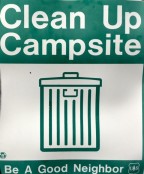

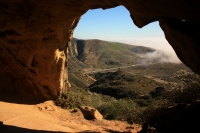
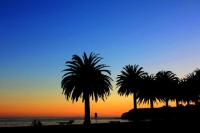

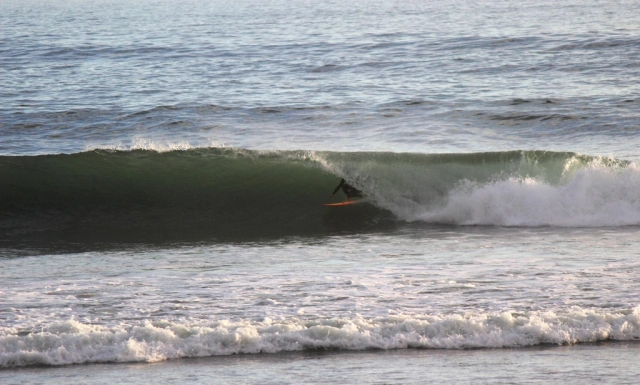
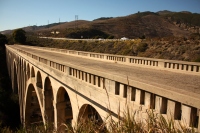
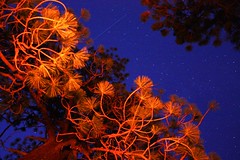








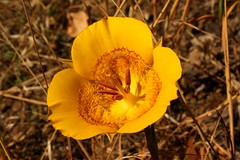








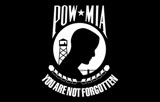
That is just unbelievable! I never imagined such a thing could have happened in what is usually such an agreeable climate. Thanks for sharing this interesting information!
Amazing,glad I was not there.
Jack, you’ve outdone yourself again! I couldn’t read it fast enough. What was the deal with the dust cloud? Was there a fire earlier that year in the backcountry? I remember in Oct and Dec 2007 we had huge post Zaca Fire dust clouds. Great stuff, thanks.
Hey Bryan. I remember those dust clouds you mention! I have thought about those post Zaca Fire dust clouds often and wondered how they might relate to what happened back then with this event occurred. I recall one day one of those dust clouds after the fire really did blacken the sky over town. I had never seen anything like it before or since. It was a spectacle to behold!
It’s the hottest day in the United States until Death Valley eclipsed it in 1913, at 134 degrees.
Yeah, I noted that in the post when I wrote it:
“Santa Barbara’s world record remained for 75 years, until it was beat by a single degree by weather in the Mojave Desert recorded at Death Valley.”
Jack, Death Valley is my second favorite place, since I was in the 4th grade. But my very most favorite place is CONVICT LAKE, where I told my kids to bury me or scatter my ashes. Two of my kids have been to Europe twice and their favorite place was Switzerland, due ti the lakes, BUT after I took them to Convict, last year, they agreed that Convict is even prettier. I’ll be up there at the end of the month, for the 15th time, since I was first there at age 8 . Steve
Funny you should mention that area, as I was just up that way this last weekend, hence the post of the picture of East Walker River.
The Day It Rained Fried Chicken! Wow.
This is the most interesting article
This preceded the famous Carrington Event of Late August 1859. It’s believed the C – event was preceded by a earlier solar event that weakened the Earth’s protective atmosphere. Could these two events be correlated?
This sounds right. It would not have been out of the question for a big patch of ozone to be blown off by one of the massive solar flares.
Rambling Jack?
Wandering Jack.
Elliott Adnapoz
This is an amazing story, and one that the human-caused climate change believers would probably like to disappear. Turns out the 3rd highest temperature was recorded way before cars, jets, big agriculture and other big carbon producers were invented. Wake up to the climate change scam.
There are always abominablys. What top scientists,climatologists and millions are telling us and experiencing worldwide is that these record breaking temperatures have been excelling for hundreds and hundreds of days. These are documented facts not one time occurrences.
“abominablys”, really???
There are always abominablys. What top scientists,climatologists and millions are telling us and experiencing worldwide is that these record breaking temperatures have been excelling for hundreds and hundreds of days. These are well documented facts not one time occurrences.
I find this a stretch as I looked on Wikipedia of the highest temperatures ever recorded and saw nothing about Santa Barbara, and most of the records were well below this one. I was born and raised there, and its temperate climate doesn’t lend itself to these kinds of temperatures, next to the ocean, where inland deserts weren’t close to this kind of heat. If this was the 3rd highest temperature on earth ever recorded, why wasn’t it mentioned in the “temperature records”?
Hey Mark. Thanks for stopping by.
Wikipedia is open to anonymous edit from anybody. It’s not a reliable source. Many things are true that one cannot find mentioned on Wikipedia.
That’s not to say you don’t raise a legitimate point, but I wouldn’t set store by what is found on Wikipedia.
You mention the climate of SB not lending itself to this sort of extreme heat, but there are other factors, phenomenon, that could have played a part.
For instance, wind flowing down a mountain slope can warm to much higher temperatures than the surrounding air.
It need not have been that a 133 degree heat blew out of a nearby desert and hit the coast. Perhaps something along the lines of a foehn wind occurred, which took already hot air and spiked the temperature to a hellish extent.
You can read the cited US government’s “Coast Pilot of California, Oregon, and Washington Territory:” https://archive.org/stream/pacificcoastcoa00survgoog/pacificcoastcoa00survgoog_djvu.txt
Here is the relevant excerpt:
The next paragraph in the government report actually suggests, by way of the men’s personal experience, what I mentioned above about a foehn wind increasing the already warm temperatures to the realm of extreme. Here is that excerpt:
As an anecdotal aside. . .Just a few days ago it was 100 degrees in Santa Barbara proper. Yet, up on the south facing slopes of the Santa Ynez Mountains, scorched by the sun but also seared by the sun’s reflection off the ocean like a mirror, it would not surprise me to find it at least ten to fifteen degrees hotter.
So we could start there with, say, 110 heat. While I am skeptical of 133 degrees here, it seems within the realm of possibility to me, the opinions of purported experts not withstanding, that a strong wind could then take that heat and, driving it rapidly down slope, increase the temperature another 20 degrees.
Now perhaps this phenomenon does not occur around here, but in places where foehn winds have been observed such a significant spike in temperature is not unknown.
What we do know, as residents of Santa Barbara, is that we have warm, dry winds out of the interior blowing over the coast and offshore which are commonly called the Santa Anas or sundowners. And I have, within the last ten years, seen two occasions where strong winds blowing over the Santa Ynez Mountains from the interior raised huge dust clouds; just as is mentioned in the cited government report.
After the Zaca Fire came the largest of these dust storms, but it also happened about a week ago when strong hot winds blew over the Santa Ynez Mountains and kicked up ash and dust from the Sherpa Fire along Gaviota Coast. I happened to be fishing the ocean at the time trying to get some respite from the heat and watched as the dust storm blew down from the mountains and out over the sea like a river. The airborne river of dust and ash completely blotted out the mountains from view.
This is a most interesting story and lesson, but not so much for its meteorological information. I have heard this from a few diverse and respected sources over the years, generally believed it and repeated it myself. However, thinking about heat and climate lately, it dawned on me how absurd it was, and how I couldn’t really recall a few key facts, so I revisited it. And, well… it almost certainly never happened. And for all the climate change deniers, sorry guys, carbon dioxide is in fact a greenhouse gas.
For one, it makes no sense, and is highly improbable. Where did this super heated air come from? Secondly, Tompkins book is the only source, other than the 1869 US govts version, which was written a full 10 years after the event took place (the simoon supposedly happened in 1859). So the US govt account was a relation of a decade-old local tale, not an actual recording. The event has absolutely no significance as a true temperature record, other than in lore, and is no where considered as such. This can be confirmed by checking the records.
One version I’ve heard is that it “would have been lost and relegated to local lore had a USGS vessel not been offshore to record the event”. Now Im not sure if thats actually what Tompkin’s wrote, but the USGS first formed in 1879, a full 20 years after this supposed simoon. As if California had a USGS boat in operation in 1859… a mere decade after the initial gold rush of ’49? California was barely getting started.
This podcast called skeptoid did a good job of shooting it down: https://skeptoid.com/episodes/4424
The story is interesting, but as a case study in people believing everything they hear (and making excuses for it). Not to denigrate the author of the book, or this blog, but for the sake of accuracy, I think its worth noting that this most likely did not occur, and there is no hard evidence for it. Thats the truth!
You need to read the post before commenting.
“but for the sake of accuracy, I think its worth noting that this most likely did not occur,”
Thanks for stopping by and taking the time to type all of that out, but I noted that point six years ago, in the body of the original post.
“So the US govt account was a relation of a decade-old local tale, not an actual recording.”
Yes, that is correct, as I already noted, as the excerpt I quoted in the comments makes clear, where I also provided a link to the actual government report.
You’re repeating what’s already been covered.
“but the USGS first formed in 1879, a full 20 years after this supposed simoon. As if California had a USGS boat in operation in 1859… a mere decade after the initial gold rush of ’49? California was barely getting started.”
Since you expressed a passion for accuracy you might want to know that the United States Coast Survey was the government agency that produced the report. I stated that fact in the post. It was not the USGS.
Also, the United States Coast Survey is a federal agency that was first created in 1807.
So your mention of the USGS and of California as if the state was the one that owned the boat on survey, rather than the federal government, does not make any sense.
An accurate reading of my original post should have made all these points clear.
Hello,
Yes, my bad, I noticed the update right afterward. And I mixed the USGS and USCS, I think because I had originally heard versions of this with USGS in there. The power of rumor! Anyway than you for the corrections.
Strange note at the bottom of the article wrt UCSB Geology Dept. discrediting this. I learned this at UCSB by the oldest and best Geology teachers Dr. Sylvester.
I’m calling bullshit on this one.
You have to remember, recorded temperatures are air temperatures, in the shade. In the in sun, it’s a least 10 degrees hotter. Probably closer to 20 degrees. Nature’s barbecue indeed.
After last weekend’s temperatures here in Santa Barbara county, I believe this!
Unfortunately, just like high temperatures in Saudi Arabia and Death Valley, current temperature models say it couldn’t happen, so measured and recorded data has been altered to fit current models.
Science used to alter models to fit data.
Could it have been a ufo taking off in the backland causing the high temps then the gust of wind with dust. Just kidding but truly the devil wind
Please fix the link to the UCSB Geography Dept. article:
https://geog.ucsb.edu/goletas-great-simoon-of-1859/
Thank you!
I have a Newspapers.com subscription. The Sacramento Bee 6-28-1859 pg 4 quoting from The Phare, a French newspaper published in San Francisco, gives the same story of 133 degrees at 2 PM, 122 at 5 PM, and 77 degrees at 7 PM. Also describes the sunburned fisherman and dead animals, fruit cooked on trees. Same paper 7-9-1859 pg 1 reports that the schooner Jeanette, which was driven ashore near SB on 17 June has been safely off. The Placer Herald 7-9-1859 pg 3 quotes the story from the Santa Barbara Gazette of the “sirocco” of June 17th, which gives all the same details as the Thompins story, but not the recorded temps. The Marysville Daily National Democrat 7-19-1859 pg 2 quotes the Gazette as reporting a series of fires raging, day and night, in the mountains near Santa Barbara for the past five weeks in succession. Yes, I believe it happened.
Thanks, Dave. I appreciate you mentioning that.